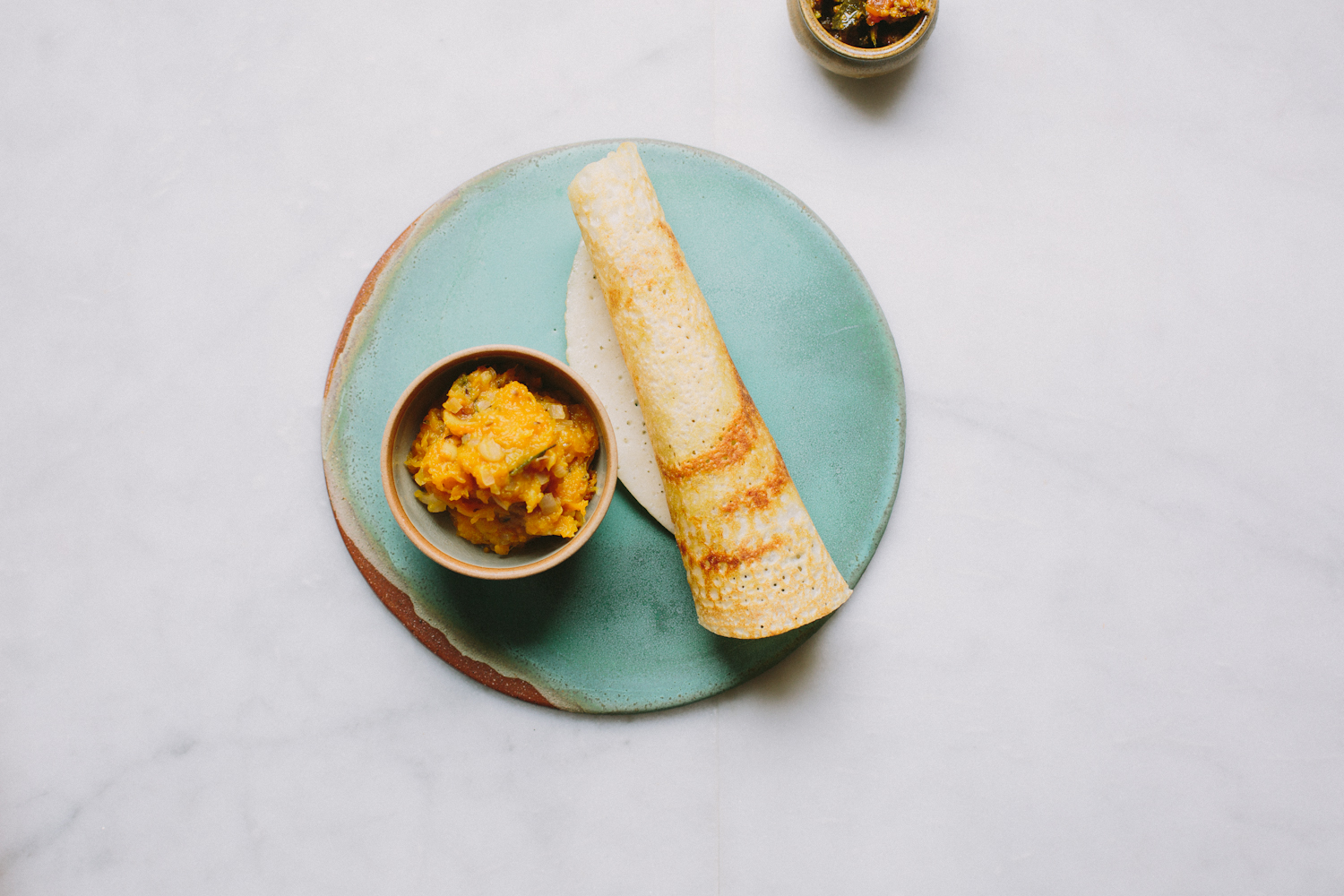
My first taste of masala dosa came at a road-side stall in the middle of the night somewhere on route to Diu Island, on the South-West coast of India nearly 20 years ago. It was love at first taste and one of the strongest food memories I have of that trip. Ever since then I’ve always got my eyes peeled for dosa on offer at restaurants and for a time when we lived in Perth I got into a routine of making them regularly, something I somehow let slip once we moved back to New Zealand, until now. When I was asked to feature a recipe from the newly released cookbook Dosa Kitchen, written by Nash Patel and Leda Scheintaub, I didn’t hesitate even for a second. Dosa are one of the most magical things, especially for us gluten-free folk! Made simply from rice and dal, these fermented pancakes, or crepes should I say, are incredibly versitle and have a lovely sourdough like tang and a crispy or chewy texture, depending on which part of the dosa you are eating. While the following recipe may at first seem daunting, it really is a straight forward process and really all you need is a little patience, with the soaking and fermenting being the longest part of the batter prep. Once your batter is made however, it will store happily in the fridge for up to a month and only take mere minutes to cook, making it the perfect thing to make over the weekend for later use during the week.
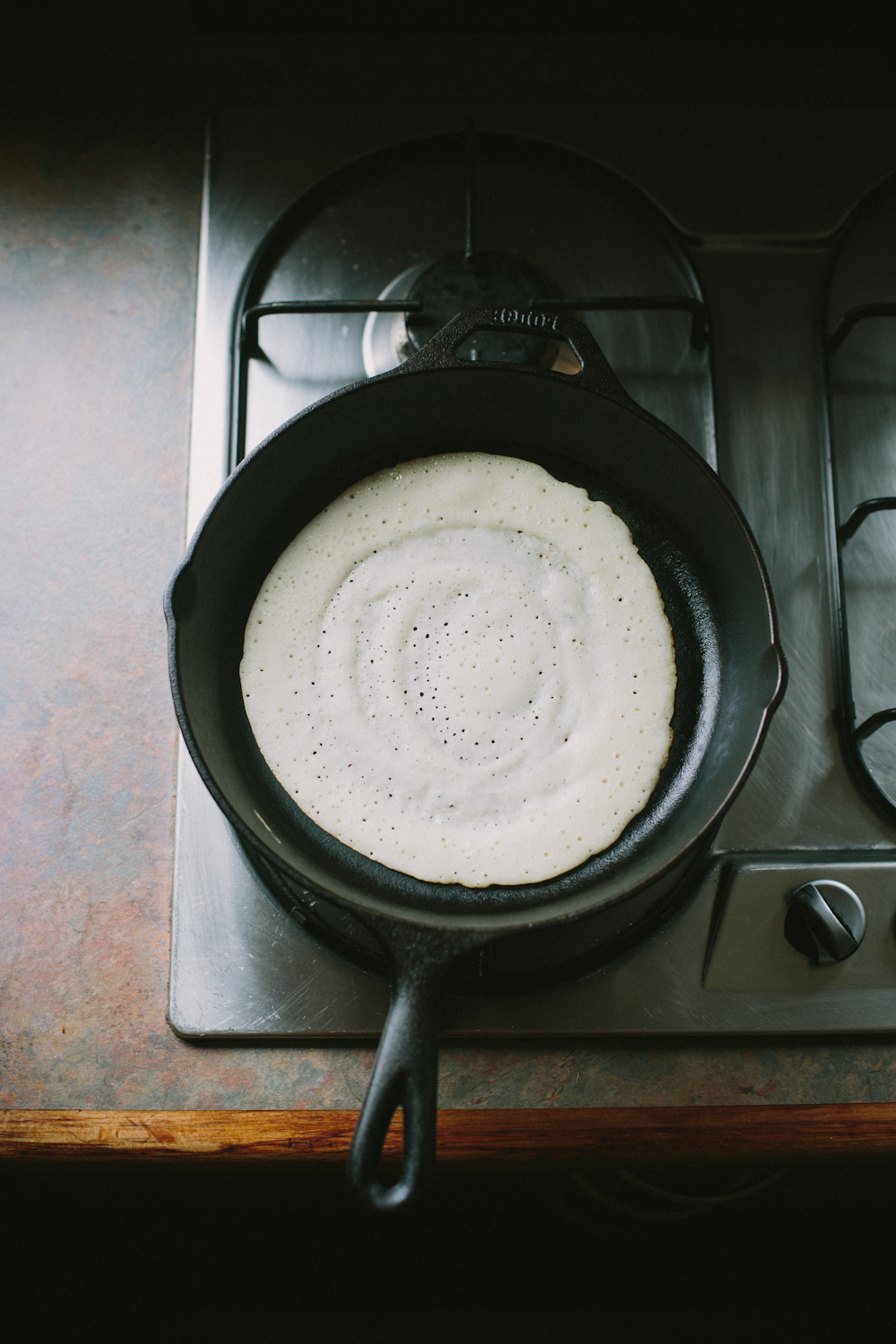
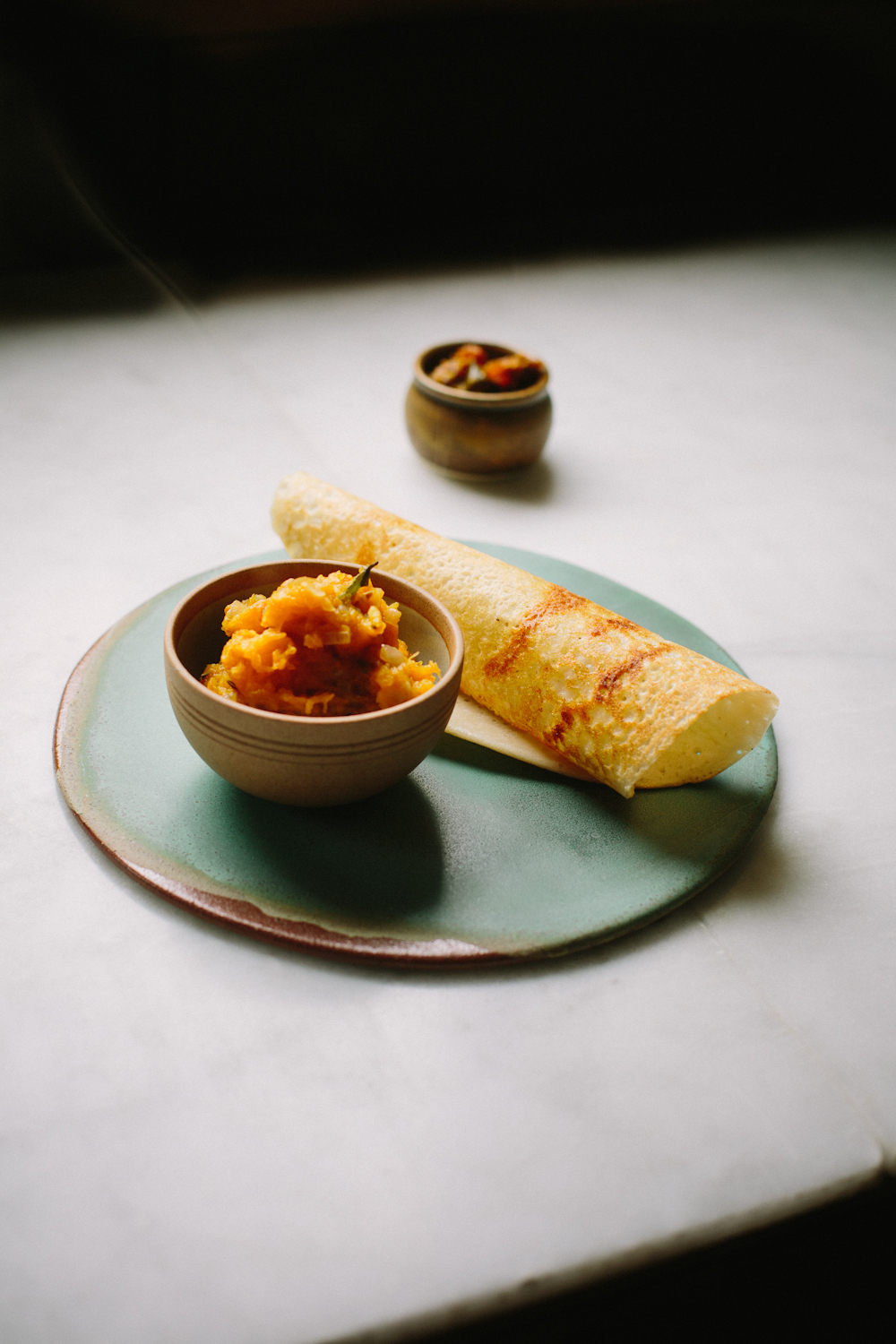
Now I’ve only ever eaten dosa with curry, such as this golden butternut squash recipe below, but with an entire book dedicated to dosa, there’s so many different serving variations I would have never thought of, both savoury and sweet! I’m looking forward to trying the Paneer Kinpira and Black Sesame Dosa Pancake and also the sweet Cardamom Chocolate Dosa and my kids can already vouch for the Cheese Dosa Pancakes, the Indian version of quesadilla (genius!).
I’ve shared the recipe below as printed in the book, however there were a couple of notes I wanted to also add. My batter took 3 days to ferment in this NZ winter cold, so I would use your eyes and nose as a guide more so than the specific times mentioned below if it’s cold where you are too. You want the batter to be slightly sour smelling and bubbly before adding the salted water. You can use ghee to cook the dosa if you eat dairy, however I’ve used coconut oil myself. I used a mixture of white jasmine and basmati rice as that’s what I had at hand, the recipe doesn’t specify what white rice, but I’d stick with any long-grain white rice. Also note for my NZ/AUS readers, I used one medium butternut squash/pumpkin for this recipe and to cut down on the cooking time I simply sliced the whole pumpkin in half lengthwise and roasted for about 50 minutes before scooping out the seeds and discarding, then scooping out the flesh to use in the masala.
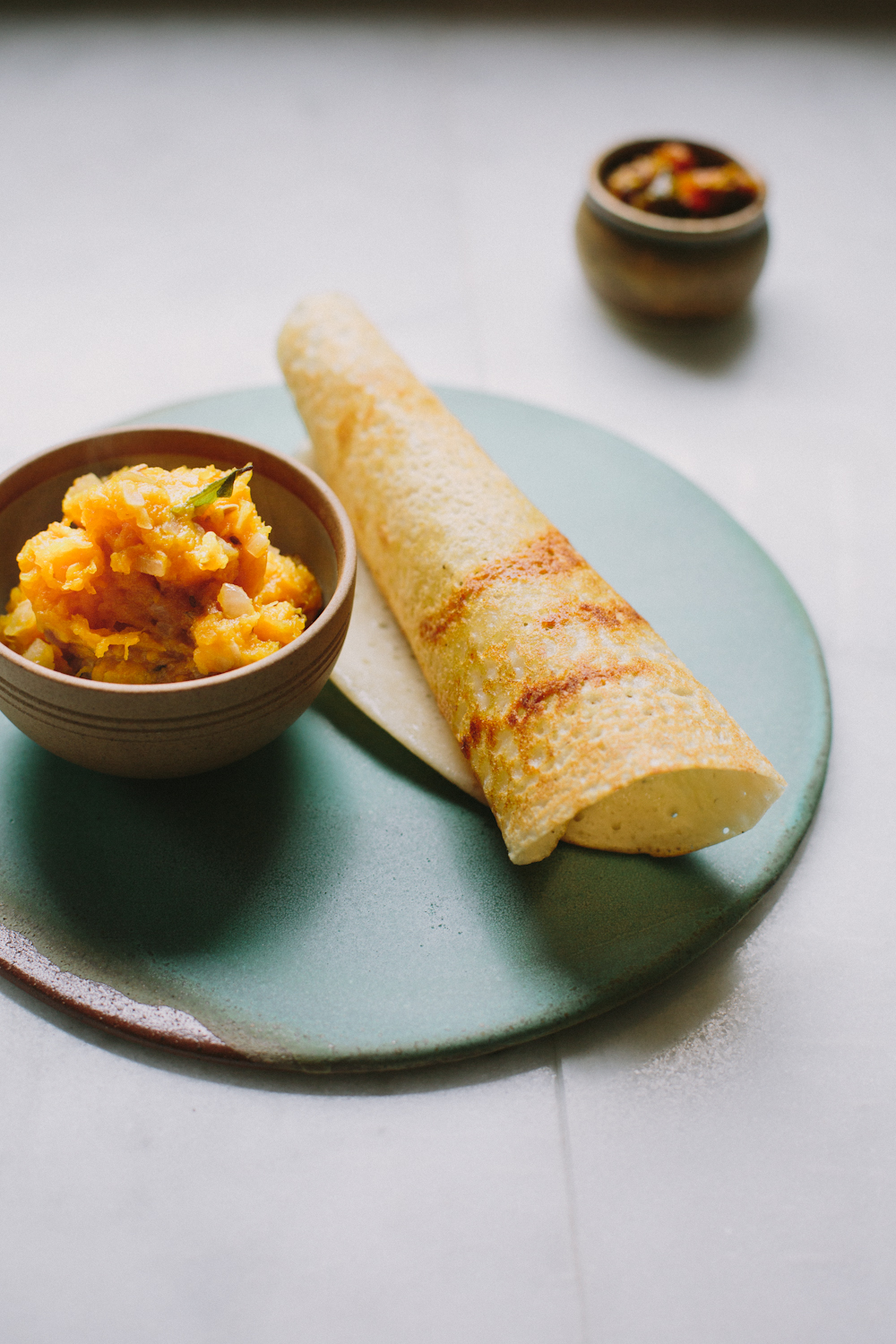
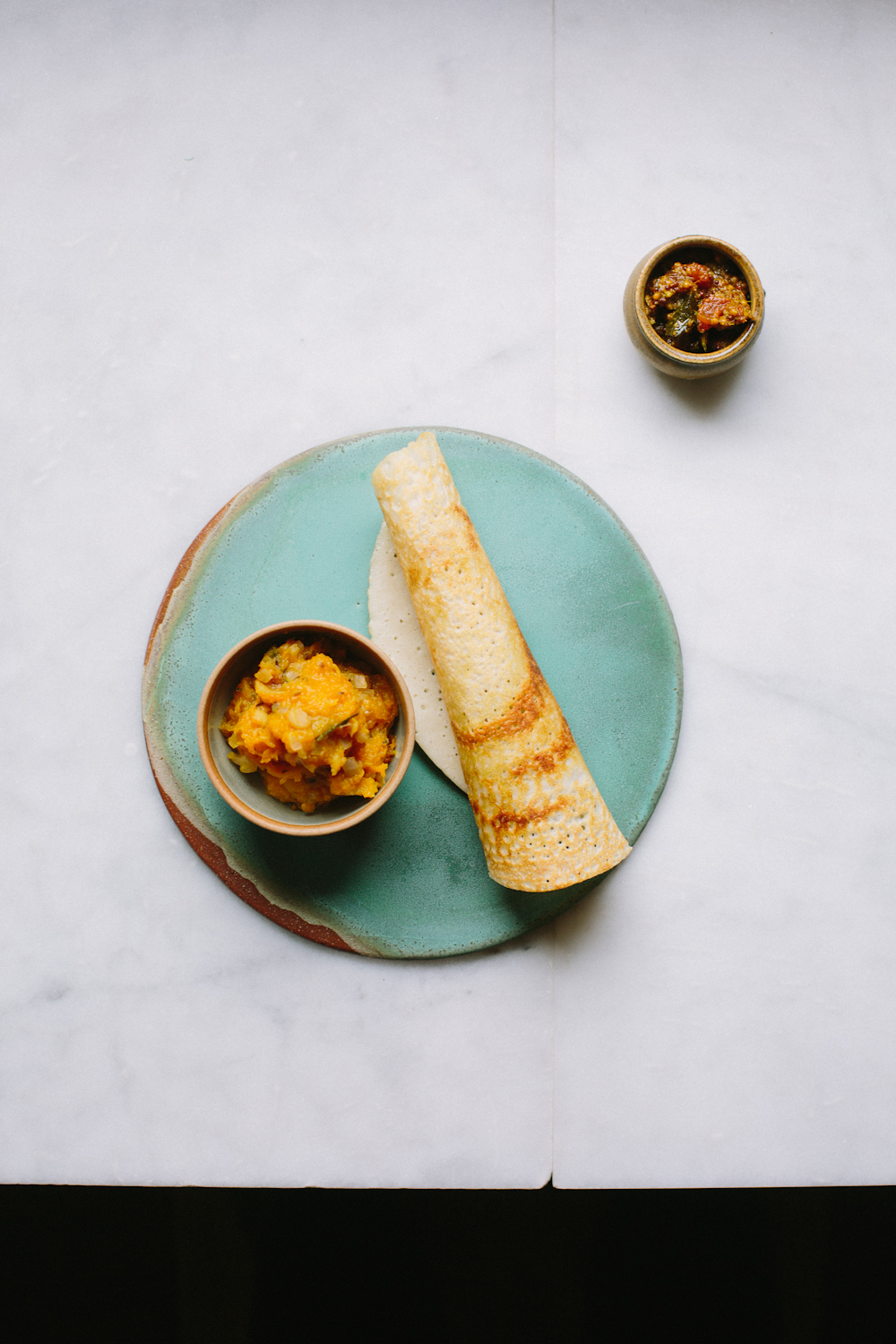
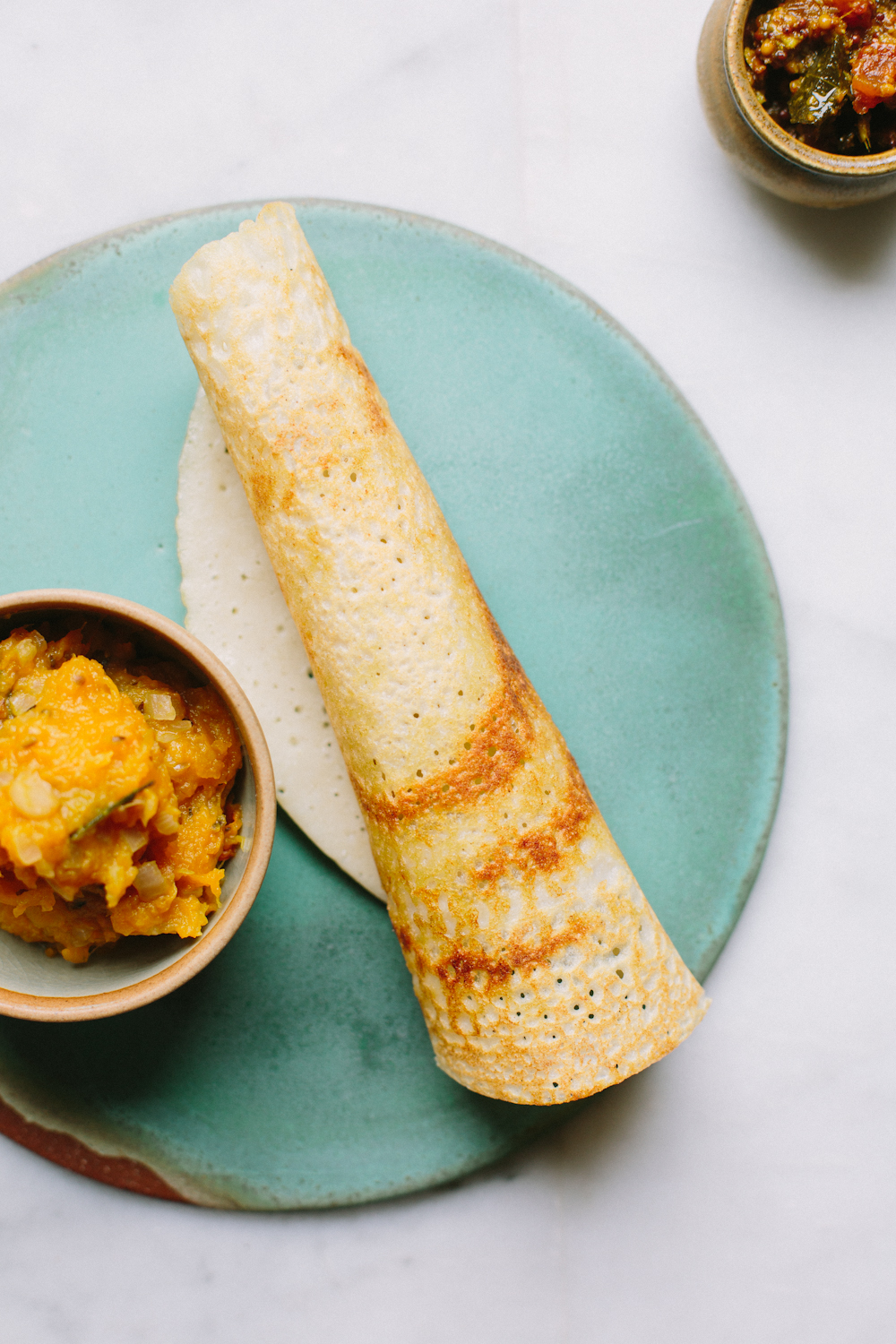
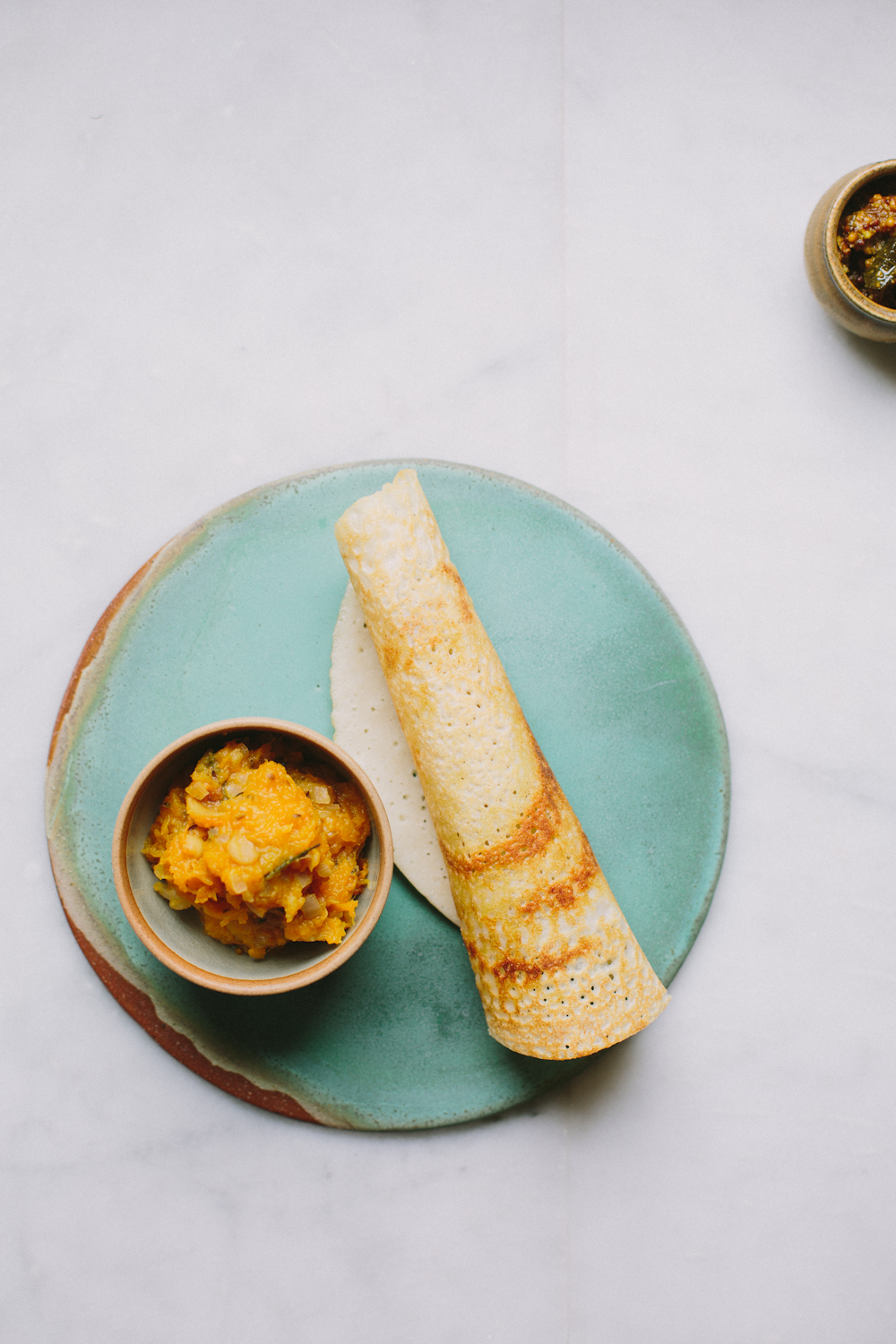
Dosa batter keeps for up to 1 month in the refrigerator, so you might consider doubling the recipe to have batter on hand for multiple meals, snacks, and dosa desserts. Use filtered water for your dosa batter, as the chlorine found in most tap water may interfere with fermentation.
Makes 8 to 10 crepe-style or pancake-style dosas, or 12 to 16 dosa wraps
Fermenting time: 8 to 12 hours
2 cups white rice
1 cup split urad dal
3 tablespoons chana dal
½ teaspoon fenugreek seeds
2½ teaspoons sea salt, plus more as needed
Melted coconut oil
SOAK THE RICE AND DAL: Place the rice in a large bowl and rinse with two or three changes of water, until the water is just about clear. Cover with water by about 3 inches.
Place the urad dal, chana dal, and fenugreek seeds in a medium bowl and rinse with two or three changes of water, until the water is just about clear. Cover with water by about 3 inches.
Cover both bowls with dish towels or loose-fitting lids and set aside for 4 to 8 hours.
Drain the rice, reserving the soaking water. Drain the dal and discard the soaking water
MAKE THE BATTER: Transfer the rice to a blender and add ½ cup of the reserved rice soaking water. Start blending on low speed and slowly add another ½ cup water through the hole in the lid while increasing the speed of the blender to high. Blend until the rice mixture is mostly smooth but still a bit grainy (when you rub a bit of batter between two fingers, it should feel slightly gritty) and the consistency of thick pancake batter, 2 to 3 minutes total. Add more of the reserved rice soaking water, about 2 tablespoons at a time, as needed to keep the blender moving, keeping in mind that the less water you add, the thicker the batter will be and the better the batter will rise. Transfer the rice batter to a nonreactive bowl that holds at least 4 quarts.
Put the dal in the blender (no need to clean it first), add 1 cup of the reserved rice soaking water, and blend until completely smooth, starting on low speed and increasing the speed as the dal starts to break down, stopping to scrape down the sides as needed, 2 to 3 minutes. Add more reserved rice soaking water, about 2 tablespoons at a time, as needed. Add the dal to the blended rice and with clean hands, thoroughly combine the two mixtures into a batter.
NOTE: Mixing dosa batter with your hands is an old tradition that is said to jump-start fermentation; we don’t know the science behind it—perhaps it has something to do with the energy your hands convey or, more concretely, the aeration your fingers provide—but we find it to be true.
FERMENT THE BATTER: Cover the batter with a clean dish towel or loose-fitting lid, put it on a baking sheet (to catch potential bubbling over), and place it in a warm spot (90°F is optimal) for 8 to 12 hours, until the batter is thick and foamy, nearly doubled in volume, and smells slightly sour. If your batter looks like the aftereffects of a small volcanic eruption or a science experiment gone wild, congratulations—it is very nicely fermented.
In a liquid measuring cup, dissolve the salt into 1 cup water, then pour it over the batter and whisk it in, breaking up any hardened top layer that might have formed. Transfer to a large nonreactive container, cover, and refrigerate for at least 2 hours before making your dosas.
PREPARE TO MAKE YOUR DOSAS: Remove the dosa batter from the refrigerator and bring it to room temperature, about 30 minutes. Whisk the batter until homogeneous. It should be the consistency of pancake batter; if it’s too thick, add water as needed.
Fill a small bowl with about ½ cup water and a separate small bowl with about ¼ cup oil. Take a triple layer of paper towels and fold them in half, then in half again. Alternatively, insert a fork into the root end of an onion half so the cut side is facing down. Fill a squeeze bottle with oil. (Note: The bowls of water and oil are for greasing the pan; the oil in the squeeze bottle is for drizzling over the dosas as they cook.)
TO MAKE 10-INCH DOSA PANCAKES (UTTAPAMS) OR WRAPS: Heat a 10½-inch round griddle pan over medium-high heat. The pan is ready when a few drops of water flicked onto it sizzle. Grip the paper towels with tongs (or pick up the speared onion half), dip into the bowl of water and then lightly into the bowl of oil, and rub around the pan to grease it and to tame the heat.
Ladle the batter—about ¾ cup for pancakes, ½ cup for wraps—onto the pan and quickly but methodically spread the batter with the bottom of the ladle in a circular motion from the center out to create a 10-inch round.
When small holes form on the surface of the dosa, squeeze a generous amount of oil from the squeeze bottle over the surface, getting it into the holes to crisp the dosa. When the bottom turns golden brown and the top is set, about 2 minutes, flip the dosa and cook on the other side for 2 to 3 minutes more, until lightly browned and cooked through. Repeat to make as many dosa pancakes or wraps as you like, adjusting the heat as needed to turn out dosas that are crisp but not overly browned and adding more water or oil to the bowls as needed. If your pan gets too hot, your dosas may stick or burn before cooking through. To check, splash a tiny bit of water into the pan; it should sizzle but not smoke. To regulate the heat, lower the heat a little, dip your paper towels (or onion half) in water, and then oil, and rub over the pan before making the next dosa.
TO MAKE 18-INCH CREPE-STYLE DOSAS: Preheat a large electric griddle to high.
The griddle is ready when a few drops of water flicked onto it sizzle. Grip the paper towels with tongs (or pick up the speared onion half), dip into the bowl of water and then lightly into the bowl of oil, and rub around the griddle to grease it and to tame the heat.
Ladle about ¾ cup batter onto the griddle and quickly but methodically spread the batter in a circular motion from the center out to create an 18-inch thin, oval crepe.
When small holes form on the surface of the dosa, squeeze a generous amount of oil from the squeeze bottle over the surface, really getting it into those holes to crisp the dosa. When the bottom turns golden brown and the top is set, about 2 minutes, remove the dosa from the pan. Thin dosas usually need to cook on only one side, but if the top seems pale, you can flip the dosa and leave it to brown on the second side for a minute or so.
Repeat to make as many dosas as you like, adjusting the heat as needed to turn out dosas that are perfectly crisp but not overly browned.
SUNSHINE SQUASH MASALA DOSA
Sunshine squash is an orange-skinned kabocha squash; if unavailable, you can substitute any kabocha-type or butternut squash/pumpkin.
Serves 4 to 6
1 (3- to 3½-pound) sunshine or other kabocha squash
2 tablespoons coconut oil
½ teaspoon black mustard seeds
1 teaspoon fennel seeds
½ teaspoon cumin seeds
2 dried red chiles, broken into pieces
1½ tablespoons chana dal
Handful of fresh curry leaves
Pinch of asafetida (optional)
1 large red onion, chopped
2 teaspoons minced fresh ginger
1¼ teaspoons sea salt, or to taste
½ to ¾ cup full-fat coconut milk
4 to 6 Classic Dosas or Dosa Wraps (see above)
Chutney, to serve, optional
Preheat the oven to 200°C (400°F).
Using a sharp knife, carefully make slits all over the squash. Place it on a baking sheet and bake for 1½ to 2 hours, until softened and starting to collapse. Remove from the oven, halve the squash lengthwise, and let cool; then remove and discard the seeds and skin and break the flesh into large pieces.
Temper the spices: Heat the oil in a large saucepan over medium-high heat until very hot but not smoking. One immediately after the next, add the spices without stirring: first the mustard seeds ( they will start to pop), followed by the fennel seeds, cumin seeds, red chiles, chana dal, curry leaves, and asafetida, if using. Let the fennel seeds, cumin seeds, red chiles, chana dal, and curry leaves darken a couple of shades without burning.
Add the onion, reduce the heat to medium, and cook for about 3 minutes, until lightly browned but still fairly crisp. Add the ginger and cook for about 2 minutes, until the ginger is softened but the onion is still slightly crisp. Add the salt.
Add ½ cup coconut milk, bring to a simmer, and cook for 2 minutes. Add the squash and mash with a potato masher to a coarse or semismooth consistency, as you like. Stir to heat the squash through, adding more coconut milk if necessary to moisten and break down the squash to a scoopable consistency. Remove the red chiles or instruct diners to eat around them. Serve the squash mixture alongside or stuffed into your choice of dosa, with chutney if you like.
Reprinted with minor My Darling Lemon Thyme style changes from Dosa Kitchen. Copyright © 2018 by Nash Patel and Leda Scheintaub. Photographs copyright © 2018 by Kristin Teig. Published by Clarkson Potter/Publishers, an imprint of Penguin Random House, LLC.
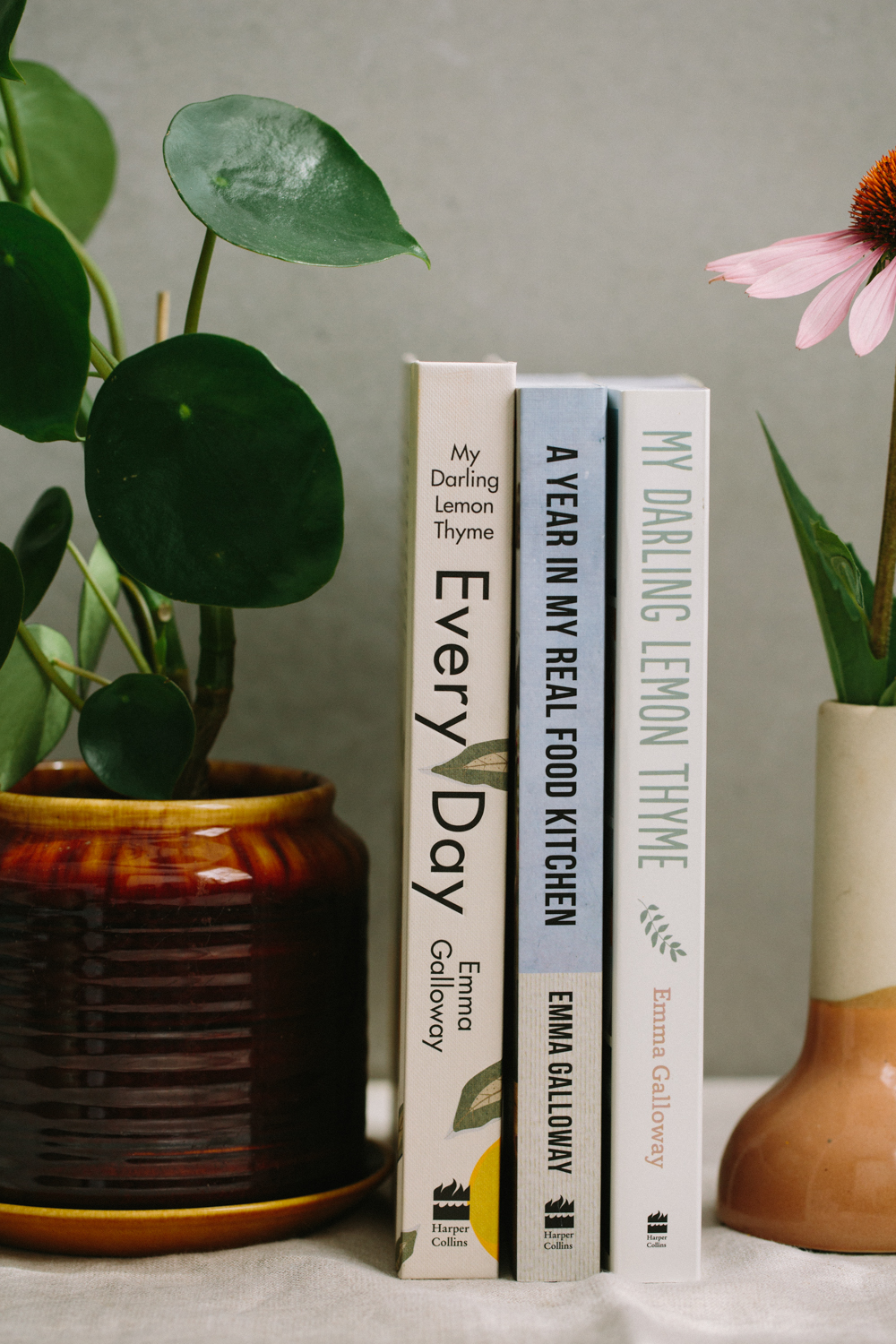




8 Responses
I’ve never tried to cook something like sunshine squash masala dosa before. Thanks for the recipe. This two has a great combination and surely perfect for breakfast.
Good article
Buying ingredients online right away! Thank you for sharing.
I’ve never fermented food before. Would it be ok to leave overnight outdoors? I live in South Florida so it is pretty hot out.
Hey! I’ve not left it outdoors overnight… do you mean actually outside your house? Or just outside of the fridge? No need for outside your house. Just leave it on your kitchen bench x
Since it said 90F was ideal, I meant outdoors. Lol, am I exaggerating?
Just inside on your benchtop is fine 🙂
It seems to be very tasty and healthy. thanks for sharing.
Unusual but looks like a great idea. Must get the ingredients and make an effort.
Cheers form the English lake district.